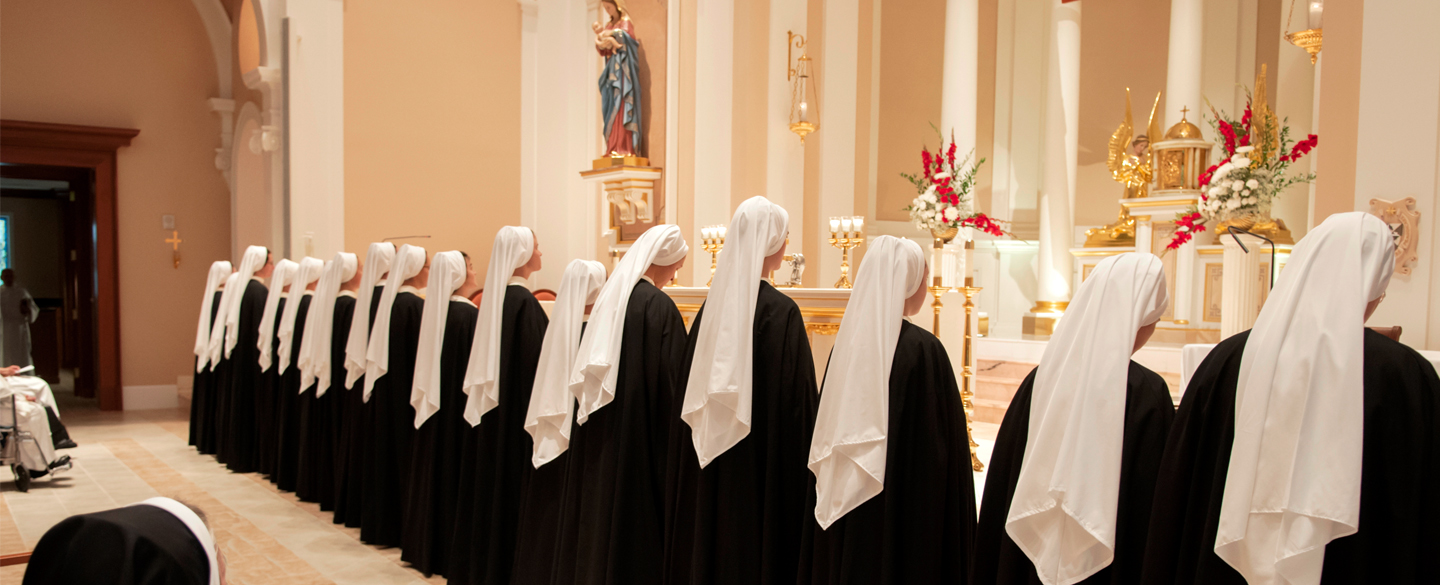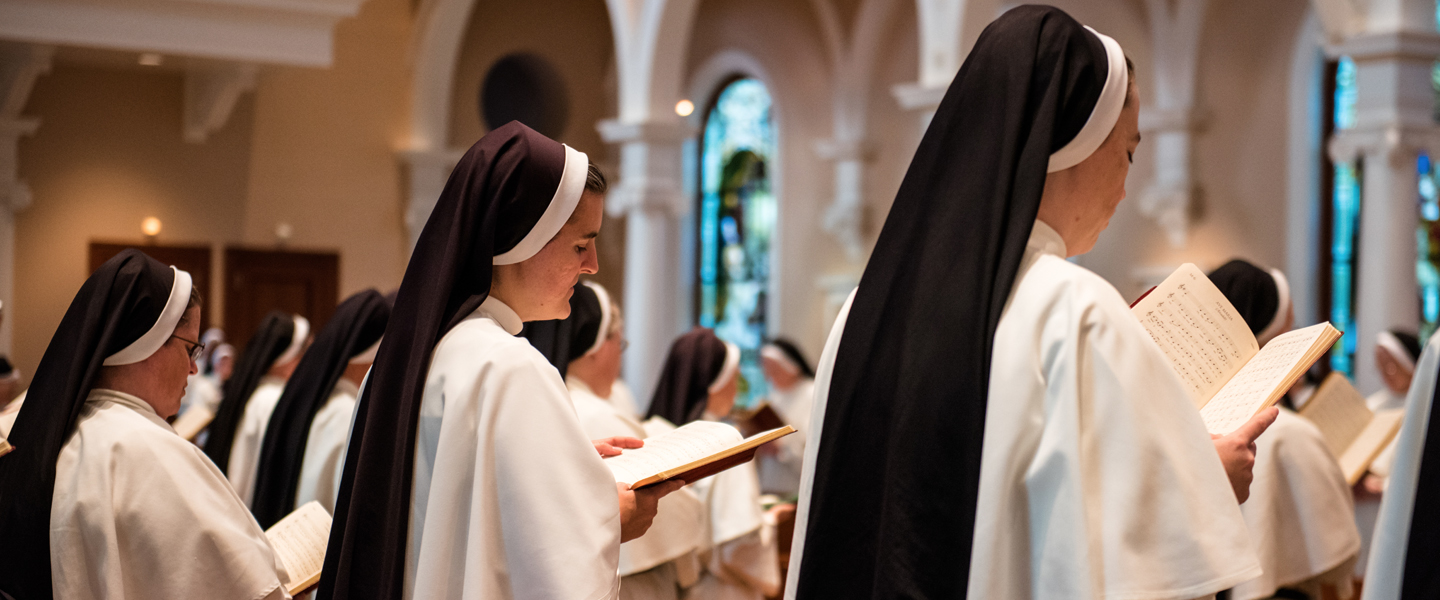
Thus rooted in Christ and His Church, St. Cecilia is known as a joyful, dynamic community, a city “built on the mountain,” a sign of hope and encouragement for the faithful and an attraction for young women who generously join its ranks. St. Cecilia’s has been faithful to the Lord, to His Church, and to the many committed to its apostolate in education, evangelization, and prayer. (Cardinal Augustin Mayer, OSB)

The Great Jubilee
For the Congregation, the preparation for the year 2000 began in 1997. For a number of years the entire community had studied major documents of the Church which dealt with Church teachings in general (for example, The Catechism of the Catholic Church) and on religious life in particular (such as Vita Consecrata and Fraternal Life in Community). During the 1994 Synod on Consecrated Life, Pope John Paul II recommended that religious orders celebrate the Jubilee by revisiting the charism of their founders. The Great Jubilee was to be an opportunity for grace and renewal for religious. For three years prior to the Jubilee of 2000, our community formally studied in stages the person and charism of St. Dominic, the history of his Order and the saints and blesseds who lived faithfully the call to promote truth. This reimmersion in the heritage of our Order, a direct response to the Great Jubilee, was entitled “Behold the Heritage,” alluding to a deathbed exhortation in which St. Dominic is said to have encouraged the friars to “Behold the heritage I leave you.”
Another dimension of this call to “Behold the Heritage” was the opportunity to travel to the lands in which St. Dominic had lived, preached and founded the Order. After years of savings, Mother Christine and her Council made it possible for the sisters in the community to make a pilgrimage to Spain, France and Italy to experience the Order on native soil. The summer of 2000 would long be remembered as a time of renewal and rejoicing in all that is Dominican.
Aquinas College, Nashville
Aquinas College was founded in 1961 in west Nashville, on a beautiful wooded property that remains a natural oasis in the midst of an increasingly urbanized neighborhood. The college supports the education of the sisters and lay students from across the United States, Canada, Europe, Africa and Central and South America.
Aquinas began as a junior college with eight classrooms and 28 students. Mother Joan of Arc Mayo, O.P., served as the College’s first president and Sister Dominica Gobel, O.P. was appointed the school’s first Academic Dean, a position she served until her retirement 1989. The school year opened with a Mass of the Holy Spirit, a tradition that is honored at the beginning of each academic year. Aquinas College’s first graduating class of 1962 included Sister Mary Evelyn, (future president), Sister Ann Marie and Sister Rose Marie (future prioress generals).
In December 1971 Aquinas was awarded full accreditation by the Southern Association for Colleges and Schools. In the late 1960s through the mid-1970s, a series of allied health programs were offered through Aquinas. These included: radiologic technology, respiratory therapy and dental auxiliary training. In August 1983, the college began an Associate Degree Nursing (ASN) program in collaboration with St. Thomas Hospital. Before the ASN degree program was replaced by a Bachelor of Science in Nursing (BSN) degree in 2014, more than 1700 nurses were graduated from the program and have continued to make a substantial contribution to health care in the city of Nashville and beyond. Throughout the 1980s and 1990s, programs and course offerings continued to expand.
Transition to a Four Year Institution
In 1994, the college became a four-year institution with the approval of a bachelor education program. A bachelor business program was added in 1999. From 2000 until 2010, Aquinas hosted the Aquinas Primetime Program, a premier adult studies program in the city of Nashville that included degrees in business administration, management of information systems, and human resources certification. In 2007, a catechist preparation program was instituted which currently serves the dioceses of Nashville and Knoxville, TN; and Lexington, KY, including online courses to serve rural areas of the southeast.
In 2007, Aquinas was included in The Newman Guide to Choosing a Catholic College as one of the top 21 Catholic colleges in the nation. In 2009 the Center for the Study of Catholic Higher Education named the Aquinas College as "faithful and affordable". Since 2012, the College has been ranked among the top 15 by U.S. News and World Report for Regional Colleges in the South.
Responding to the New Evangelization
The call of the new evangelization has been constant and compelling. In recent years there has been a resurgence in the mission field of Catholic education. Beginning in the fall of 1996, during which period the number of sisters grew sufficient to accept new missions, the Congregation began once again to accept invitations from bishops, sending sisters to new missions. At the current time, the Congregation has expanded its apostolate to 33 schools located in the United States, including the Congregation’s own college in Nashville. The sisters are also present in 10 schools located in Rome and Bracciano, Italy; Sydney, Australia; Vancouver, Canada; the Diocese of Aberdeen, Scotland; Diocese of Roermond in The Netherlands and the Diocese of Limerick, Ireland. To see a current map of missions where our sisters serve, click here.
Such expansion has been made possible by the blessing of vocations to the community. The Congregation has experienced 64% growth since the year 2000 with 300 sisters in the community, the largest ever in our history. The median age is 36 with 58% of the Congregation under the age of forty. With an average of 18 young women entering the convent as postulants each year, the novitiate has an average of fifty sisters. For this blessing of growth and the call to give ourselves in service, we thank God.
Conclusion
At the end of her term in 1976, Mother Marie William wrote prophetic words that we can see are coming to pass in this new era of hope.
Hopefully, many of those who come after us will enjoy the fruit of our suffering—a new springtime in the Church and a reflowering of authentic religious life. As recipients of a marvelous heritage, we have so much to offer those who will be daughters of the Church in the twenty-first century.
Her statement seems a fitting conclusion of this historical summary of St. Cecilia Congregation, as do the words from Vita Consecrata: You have a glorious history to remember and to recount and a great history still to be accomplished (110).


 Back
Back